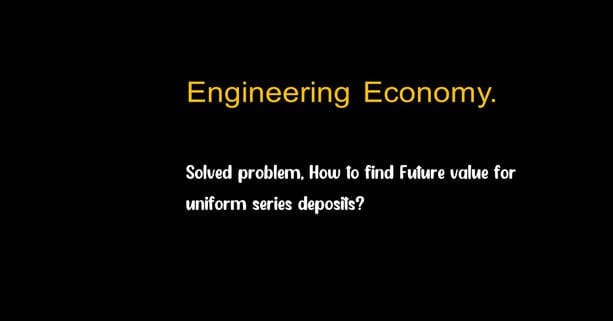Last Updated on June 15, 2025 by Maged kamel
- Solved problem: How do we find future value for uniform series deposits?
- Future value for uniform series deposits with given n, I, A.
- Use the cash flow moments method to find a future value for uniform series deposits.
- Solve For future values for uniform series deposits, use the expression for F/A.
- Future value F for uniform series deposits uses the interest table of 10%.
- For future values F for uniform series deposits, use the Excel function FV.
Solved problem: How do we find future value for uniform series deposits?
Future value for uniform series deposits with given n, I, A.
The solved problem is quoted from William G. Sulivan’s book Engineering Economy, 16th edition, Chapter 4. It can be written in the engineering economy in two ways. The first way deals with the lending and borrowing point of view. A is drawn downward as a deposit with a negative sign (-A). The second way is to describe the matter regarding the equivalence principle.
Suppose eight annual deposits of $187.45 each are placed in an account. How much money has accumulated immediately after the last deposit?
The money the man will receive will be denoted by F as a future value and drawn upwards. This future value is an inflow. The interest is 10% annually. The same problem can be asked regarding the equivalence: What amount at the end of the eight years is equivalent to end-of-year payments of $187.45 each?
The Timeline is drawn in years, with eight downward payments represented by symbol A. At the end of the eight years, there is an upward arrow for the future value. F is unknown. F is the amount to be received due to the investment of 8 annual deposits. The interest rate is 10%.

We will use the known formula to get F for given A; the equation will be written as F=A*(F/A,i,n). A will go with A and F, as both sides are identical.
F=A*(F/A,10%,8). First, we will put A’s value in the equation equal $187.45.
Use the cash flow moments method to find a future value for uniform series deposits.
If we use the concept of cash flow moment, we start by writing the given data as A=$187.45&i=10%,n=8, while F is unknown.
Take a moment about a pivot point at n=8 and write that the sum of all moments equals zero. F*(1+i)^0-A*(1+i)^7, the moment of first A is considered about a right point with time=8-1=7, A is minus, and the distance raised to the power with a positive sign, the second moment due to the second A will be -A*(1+i)^6.
The third moment due to the third A will be-A*(1+i)^5-A*(1+i)^4-A*(1+i)^3-A*(1+i)^2-A*(1+i)^1-A*(1+i)^0=0.
We simplify the sum elements, for (1+i) equals 1.10, and A is a common factor for each aspect. We will consider the corresponding value of the exponent.
The first exponent is 7, the second exponent is 6, the third exponent is 5, and so on, with a decrease of 1 for the next term.
we can get F=A*((1.1)^7+(1.1)^6+(1.1)^5+(1.1)^5+(1.1)^4+(1.1)^3+(1.1)^2+(1.1)^1+(1.1)^0. The value of (1.1)^7 is equal to 1.9487, while (1.10)^6=1.7715 and (1.1)^5=1.6105. We will check the number of exponents as eight values.
Finally, we get (1.9487+1.7715+1.6105+1.4641+1.331+1.21+1.1+1). The sum of these values is 11.4358.
We will multiply the previous value by A’s value, which is $182.45. Finally, we get F=$2143.60.
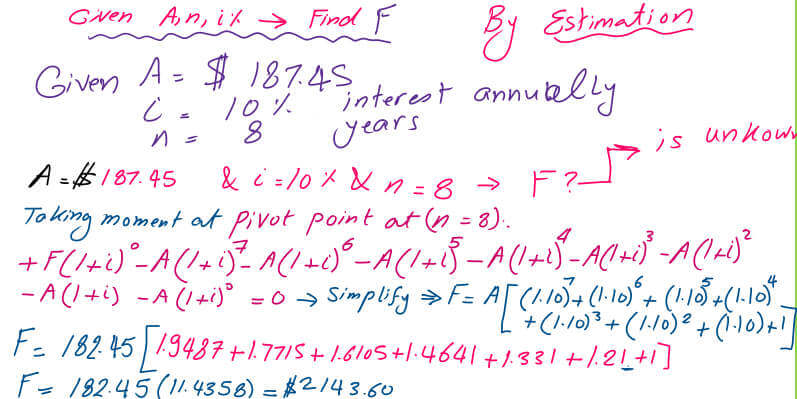
Solve For future values for uniform series deposits, use the expression for F/A.
The expression of F/A is used for a given A, and it is required to estimate the present value.F/A is equal to ((1+i)^n-1/(I).
The reciprocal of F/A will be A/F, and the A value for a given F value or future value can be obtained. A/F=(I)/((1+i)^n-1)).

Future value F for uniform series deposits uses the interest table of 10%.
We need to estimate the value of F/A by using a table showing the interest rate of 10% for n of 8 years. Before starting using the table, first, we will use the expression for F/A, which is equal to ((1+i)^n-1))/i. We have i=10% and n=8. The value of F/A=((1.10)^8-1/(0.10)=11.4358 and can be approximated to 11.436.
If we wish to use the table, we select the table for the interest of 10% and use the title uniform payment series. The Compound amount factor finds F, given A, title F/A. We go down until the horizontal line intersects at n=8. The intersection will give a value of 11.436.
This is the formula F=A(F/A,i=10%,n=8)=$187.45*11.436=$2143.67.
This is the formula F=A(F/A,i=10%,n=8)=$187.45*11.436=$2143.67.
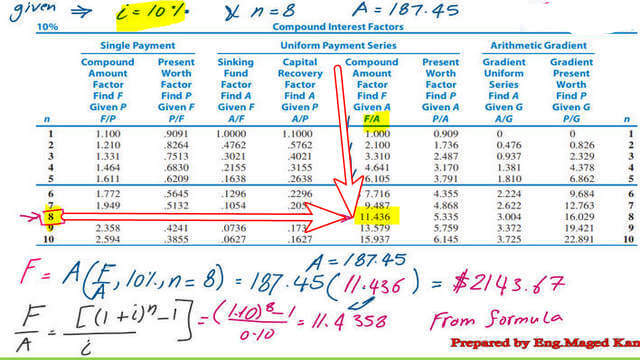
For future values F for uniform series deposits, use the Excel function FV.
I can use an Excel sheet and write the necessary elements arranged based on the generic formula of the FV function, which is the future value.
The function in Excel is FV(I, n, A). The F/A name is a uniform series compound amount. The term A/F is the name of a sinking fund; find A with a given F. This is the equation used to get the value of A/F. This is the standard notation A=F(A/F, i,n).
We write Fv, then open parentheses (rate, periods, payment). For example, we can write Fv (10%, 8,- 182.45). The payments are outflows, which is why they are in negative signs. The result is a positive F value as inflows.
This serves as an alarm that you have deposited; use a negative sign to get output as positive, and then you will get inflow. Use an Excel sheet. The first cell is rate =10%, for example, C19. Then, we write n in years in the next cell, which is C20, which is n=8.
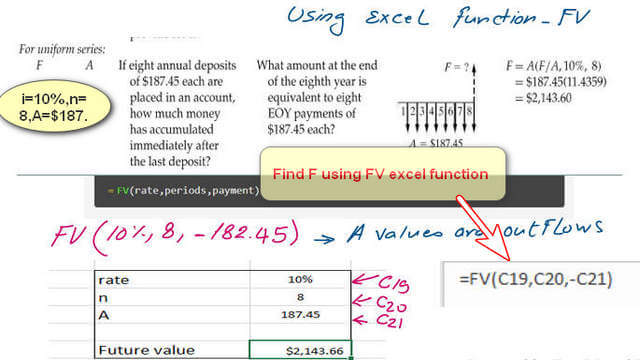
The A value is (+187.45) in cell C21.In the next cell, C22, we will write the future value as a built-in function, = Fv(C19, C20,-C21). The result is $2143.66.
Please click on any image, and you will have a slide show. Each photo will appear clearer.
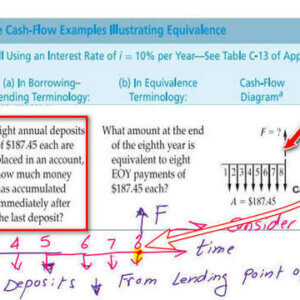
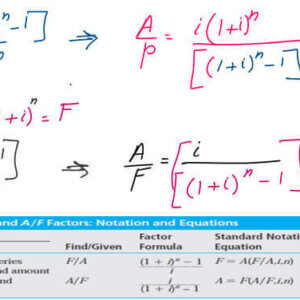
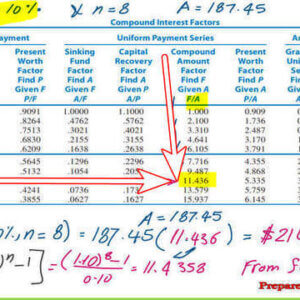
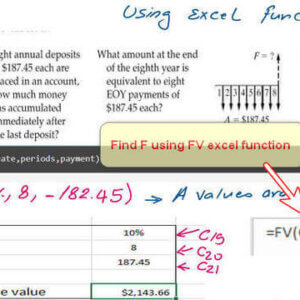
This is a good link -Engineering Economy. “A good referance
The following post-post 13 will discuss solved problems and deposit values for uniform series.

